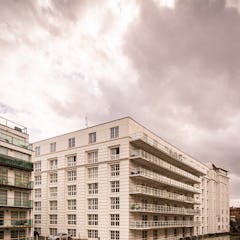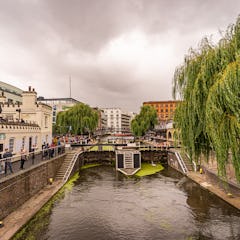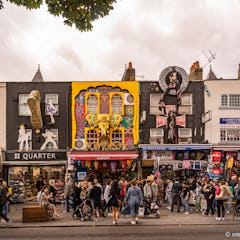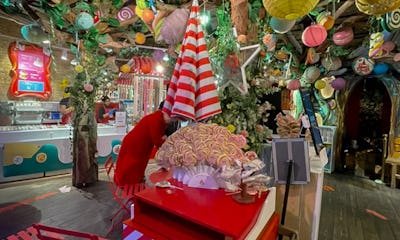History and Cultural Heritage – Camden’s Roots and Development
Camden Town’s history dates back to the 18th century, when the area began to develop into a bustling industrial hub. It takes its name from Charles Pratt, the first Earl of Camden, an influential politician and lawyer who purchased extensive tracts of land between Hampstead and Tottenham Court Road in the late 1700s. The master plan for Camden was significantly shaped by James Burton, one of the era’s most prominent developers, who also contributed to designing parts of Bloomsbury and the surroundings of Regent’s Park.
During the 19th century, Camden experienced rapid growth, particularly after the opening of the Regent’s Canal in 1820. The canal enabled goods to be transported directly into Central London, and Camden became a key logistics and warehouse district, characterised by numerous storage buildings and horse stables. These structures later evolved into the area’s most famous markets, such as Stables Market.
In the latter half of the 20th century, Camden underwent significant changes. As the industry faded, creative industries, alternative movements, and artistic communities emerged. Punks, goths, musicians, and artisans found a home in Camden. It was a place where they could freely express themselves. A particularly significant turning point came in 1974 with the founding of Camden Lock Market as a trading space for artisans. Its success was a catalyst for the entire area’s market culture, and Camden gradually became one of London’s most iconic and alternative neighbourhoods.
Today, Camden’s identity is built on this history. It is a bold, experimental, and diverse district that’s always a bit unconventional and beloved precisely for that reason.
Camden Market – A Haven for Alternative Fashion and Handcrafts
The Camden Market area comprises several market zones, housing over 1,000 stalls. The main areas are Camden Lock Market, Stables Market, the recently built Hawley Wharf, and Camden Market’s North Yard. Two other markets in Camden Town close to the tube station are Inverness Street Market and Buck Street Market. Some markets are covered and housed inside market buildings, while others are open-air.
The markets offer everything from handmade jewellery, vintage clothes, and rock-inspired fashion to exotic home decor and art prints. Many items are unique and produced by small, independent businesses, making Camden a fantastic place to find gifts and souvenirs that you won’t find in mass production.
Camden Lock Market was the first of Camden’s markets, opening in 1974 as a space for artisans. The market is named after the canal lock beside it and is now known for its wide array of goods, ranging from handmade jewellery and clothing to art prints and small gift items. The food stalls at Camden Lock Market are extremely popular, offering a diverse range of food options.
Camden Stables Market is situated on the site of a former horse hospital, hence its name. This maze-like complex offers vintage clothing, antiques, and unique finds. The horse statues scattered around the area are a nod to its history.
Hawley Wharf Market is the newest part of the Camden Market complex. Built along the modern canal side, it combines well-known brands with small, independent shops. There are over 30 food and drink stalls, along with a cinema and an indoor children’s play area.
Camden Market’s North Yard is located in the northern section of Stables Market, blending street food and artisan boutiques. The atmosphere is slightly calmer yet unmistakably Camden. The modern canal-side space features both established brands and small, independent businesses, including stores such as CyberDog, which sells rave and festival clothing. Highlights include the Amy Winehouse statue and Hans & Gretel, a dessert shop that particularly delights children.
Nearer the Camden Town tube station, Inverness Street Market was once a fruit and vegetable market for residents, but now primarily sells souvenirs, clothing, and street food. Although the offerings have changed, the street retains its lively atmosphere.
Buck Street Market is a modern market built from repurposed shipping containers along Camden High Street. It focuses on sustainable fashion, eco-friendly products, and plant-based food. Here, young brands, start-ups, and ethical choices come together.
The markets are open daily and are at their liveliest on weekends, when stalls, food vendors, and music performances fill the streets. On the busiest days, the area can attract up to 250,000 visitors.
Street Art and Visual Identity – Walk Through an Open-Air Gallery
Camden Town is a hub of street art at its finest. Building facades aren’t just walls but three-dimensional artworks—giant sneakers, dragons, and cat sculptures greet visitors from the fronts of many shops. In narrow alleys like Hartland Road or Hawley Crescent, you’ll discover graffiti and murals that change regularly and reflect London’s diverse culture.
Several well-known artists have left their mark on Camden’s streets. Irony, an internationally acclaimed British artist, is known for large-scale, realistic murals, particularly visible along Chalk Farm Road. Inkie, a street art pioneer and contemporary of Banksy, blends graffiti and Art Nouveau aesthetics, especially near Stables Market. Pegasus works in stencil art and is best known for his portraits of Amy Winehouse, including one on the façade of The Earl pub. John Bulley is responsible for one of Camden’s most famous views, i.e. the large "Camden Lock" painting on the railway bridge.
International artists also work in the area. Italian artist Alice Pasquini is known for intimate figurative works; Brazilian artist Alex Senna creates monochrome, cartoon-like pieces; and Aeroarts and David Shillinglaw add colourful and symbolic elements to Camden’s artistic streetscape. This street art is a vital part of Camden’s identity.
Music and Nightlife – The Heart of Camden Beats On Stage
Camden’s reputation as a centre for alternative music is well-earned. The area has been a launching pad for numerous bands and artists, including The Clash, Blur, and Amy Winehouse. Live music happens almost every night, creating an authentic atmosphere.
The Roundhouse, a former railway engine shed, is now one of London’s most impressive concert and cultural venues. The Electric Ballroom, founded in the 1930s, is a club renowned for hosting alternative rock and electronic music gigs.
The Dublin Castle is a traditional pub and live music venue where many rising British artists, including Amy Winehouse, started their careers. The Underworld is a dark, underground club specialising in metal and punk, known for its intense gigs and loyal crowd. Jazz Cafe combines a dinner experience with live jazz, soul, and R&B—a perfect spot for those who appreciate a relaxed atmosphere, live music, and the chance to enjoy performances while seated in a cosy dining environment.
Amy Winehouse – The Voice and Face of Camden
Amy Winehouse is one of Camden Town’s most famous figures. She wasn’t just a world-renowned singer-songwriter but also a Camden resident and a recognisable face on its streets. Winehouse was known for her unique style and music, both of which were closely intertwined with Camden’s rebellious spirit.
She performed regularly at The Dublin Castle and other Camden music venues, and her connection to the area was so strong that a statue was erected in her memory in 2014 in Stables Market. The bronze sculpture depicts Amy with her iconic beehive hairstyle and has become a permanent pilgrimage site for fans worldwide. The statue stands in a prominent location in Stables Market near the entrance to Horse Tunnel Market.
Visitors to Camden can follow in Amy’s footsteps by stopping at places that were especially meaningful to her. The Dublin Castle pub was not just a venue for her but a community where she felt at home. The Hawley Arms was her favourite hangout, where a corner table upstairs and photos on the walls still testify to her presence. Camden Square, a quiet street slightly removed from the market bustle, was Amy Winehouse’s home during the last years of her life. Many fans continue to visit her former street, leaving flowers and messages in her memory.
Vinyl Shops in Camden Town
Camden’s musical heritage lives on not only in its live venues but also in its record stores, many of which have been around for decades. These shops offer an extensive range of music, from classic rock to underground gems, all while preserving the continuity of the local music scene.
- Camden Lock Vinyl offers an exciting selection of rock and blues classics as well as treasures from alternative music, which is a genre for which Camden is particularly known. (35b Camden Lock Place)
- Massive International is Camden’s largest reggae store, boasting a vast collection of reggae, ska, and dancehall records. (43 Camden Lock Place)
- Disc Disciples, located inside the market hall at Camden Lock Place, sells second-hand records ranging from rock and hip-hop to UK garage, often allowing customers to listen on-site with a DJ. (Camden Lock Place)
- Raven Records is a fantastic and atmospheric metal record shop featuring an extensive selection of vinyl, relevant clothing like band shirts for metal fans, a non-alcoholic bar, and excellent coffee. (24 Camden Road)
- Out on the Floor Records is a small, characterful shop on Inverness Street specialising in soul, funk, house, and techno vinyl. (10 Inverness Street)
- All Ages Records is a specialist punk and hardcore store on Pratt Street, with carefully curated selections that stay true to the genre. (27a Pratt Street)
Vintage Style and Sustainable Fashion – Camden’s Treasures
In Camden Town, vintage is a part of the neighbourhood’s deeper identity. Its boutiques offer finds ranging from 1930s dresses to 1990s band tees and quirky accessories. These shops also support sustainable consumption by offering high-quality, carefully chosen items that combine the aesthetics of past decades with today’s individualistic style.
The Vintage Collection offers a broad selection of clothing and accessories dating back to the 1930s. Rokit Vintage is a long-standing classic where the clothes and styles rotate with the seasons and trends. Located on Chalk Farm Road, Camden Thrift Store provides affordable vintage finds in a laid-back atmosphere.
Camden’s Food Culture – A Celebration of Street Kitchens
Camden’s food scene reflects its international character and experimental spirit. Particularly in Camden Lock Market and Hawley Wharf, you’ll find a world of food stalls offering culinary journeys from Thailand to the Middle East and from the Caribbean to South America. Hawley Wharf tends to offer more seating, but the street food stalls at Camden Lock Market are perhaps more exciting, and the canal-side is a perfect picnic spot. It’s worth allocating time for eating, especially on weekends when the area is at its busiest.
Coffee Culture – The Best Coffee Breaks in Camden
Camden’s café scene is as diverse as its overall identity, which is alternative, experimental, and warmly welcoming. The Coffee Jar is a small, cosy café on Chalk Farm Road known for its espresso-based drinks and vegan pastries. Saint Espresso offers modern coffee in a calm setting on Camden Road. Chin Chin Dessert Club serves spectacular liquid-nitrogen-chilled desserts near Camden Lock.
Regent’s Canal and Green Views – Tranquillity Amidst the Buzz
Regent’s Canal, Camden’s backyard, offers a peaceful counterpoint to the district’s bustling street life. Along the canal, you can walk, cycle, or join guided boat tours heading toward Little Venice or King’s Cross. One of the most popular routes runs between Camden Lock and Little Venice, passing notable sights such as the ZSL London Zoo. The route is operated by, among others, the London Waterbus Company, which uses traditional canal boats and offers a chance to see canal views from a new perspective. In summer, the atmosphere resembles that of a Central European river city. Early mornings and evenings are ideal times for photography along the canal.
Events
In addition to the daily live music events, Camden also has festivals during the year. Chinese New Year in Camden (January–February) kicks off the year in vibrant style. The Hawley Wharf area celebrates with parades, workshops, and traditional performances.
Camden Fringe (July–August) invites fans of experimental theatre, stand-up comedy, dance, and music across venues throughout Camden. Performances are mostly in smaller spaces, offering intimate cultural experiences.
Practical Tips for Visitors
Camden offers numerous photo opportunities for photography enthusiasts, with the Camden Lock bridge, the Amy Winehouse statue, street art areas, and the scenic Regent’s Canal being particularly popular. A visit is best timed for the morning or late afternoon when it’s easier to move around amidst the market crowds.
Camden Town is a visual, multicultural, and energetic experience. It’s a place where London shows its boldest side.
















